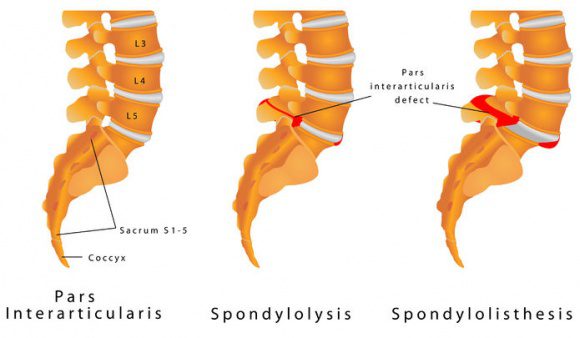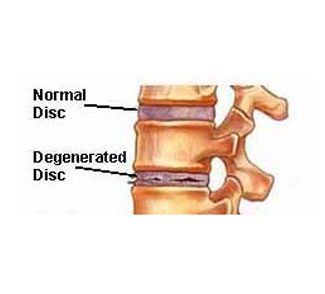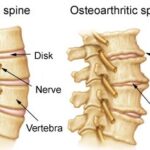Degenerative Disc Chiropractic Care

Degenerative disc disease is described as the symptoms of pain and radiating weakness or numbness stemming from a degenerated disc in the spine.
Basically Degenerative disc disease may cause back and/or leg pain, as well as functional problems such as tingling or numbness in your legs or buttocks, or difficulty walking.
While the definition sounds simple, many patients diagnosed with degenerative disc disease are left wondering exactly what this diagnosis truly means for them.
A diagnosis of degenerative disc disease is frightening to many patients because it sounds like a progressive, threatening disease. However, it is not really a disease, and it is not strictly degenerative.
Technically For most people the term degenerative implies that the symptoms will get worse with age. However, the term does not apply to the symptoms, but rather describes the process of the disc degenerating over time.Â
While it is true that the disc degeneration is likely to advance over time, the pain from degenerative disc disease usually does not get worse and in fact usually gets better when its given the time to.
Another reason why people get confused is because of the term disease. Degenerative disc disease is not really a disease at all, but rather a degenerative condition that at times can produce pain from a damaged disc.
Disc degeneration is actually a natural part of aging, and over time all people will exhibit changes in their discs consistent with a greater or lesser degree of degeneration. However, not all people will develop symptoms. In fact, degenerative disc disease is quite variable in its nature and severity.
An important thing to know about disc degeneration is that it can lead to or accelerate the start of additional spinal conditions, such as: Spinal Stenosis, Osteoarthritis in the spine, and Spondylolisthesis.

Treatments can vary depending on the severity of your symptoms and how much they limit your everyday activities.
 Here are some treatments you may consider depending on your level of pain:
Non-surgical treatments – Not all patients with pain from degenerative disc disease require surgery. For mild to moderate pain, more conservative treatment methods can include medications, physical therapy, and chiropractic care.
Spinal fusion – A procedure called a spinal fusion can be used to surgically treat degenerative disc disease.
The goal of chiropractic care for disc degeneration is to improve joint mechanics by improving spinal motion and reducing inflammation.
Dr. Mir may also work on improving the function of the intervertebral disc; as well as give rehab exercises to help open the disc spaces.
To help treat your disc degeneration symptoms, Dr. Mir may use spinal manipulation.
There are multiple types of spinal manipulation. Some common ones are:
- Specific spinal manipulation/Mobilization:Â Your chiropractor will identify the joints that are restricted or those that show abnormal motion. He or she will work to restore movement to the joints using a gentle thrusting/mobilizing technique.
- Flexion-distraction technique: This type of spinal manipulation uses a gentle, non-thrusting technique; it’s typically used to treat herniated discs and spinal stenosis.
- Instrument-assisted manipulation:Â This technique uses a hand-held instrument. The chiropractor applies gentle force without thrusting directly into the spine.
- Traction:Â This technique involves the chiropractor holding one end of the degenerative joint and pulling the two bones/ends away from each other. This alleviates pressure off the nerves and therefore helps reduce the pain.
Manual therapy may also be used to help treat disc degeneration symptoms. Some examples of manual therapy techniques are:
- Trigger point therapy:Â The chiropractor identifies tight painful points on a muscle and puts direct pressure on these points to relieve tension.
- Manual joint stretching and resistance techniques: Your chiropractor may use one of these techniques to relieve pain and other DDD symptoms.
- Therapeutic massage:Â Massage can help reduce muscle tension.
- Instrument-assisted soft tissue therapy:Â An example of this type of manual therapy is the Graston technique, which uses an instrument to reduce pain and other symptoms.
In addition to spinal manipulation and manual therapy techniques, your chiropractor may use other types of therapy to help reduce inflammation caused by DDD. Examples are:
- Interferential electrical stimulation:Â A low frequency electrical current is used to stimulate your muscles to reduce inflammation.
- Ultrasound:Â Ultrasound can help reduce muscle spasms, stiffness, and pain by sending sound waves deep into your muscle tissues. This creates a gentle heat that enhances circulation.
For those suffering from degenerative disc disease, chiropractic care is a treatment option that you may want to consider. This is because as a disc degenerates it begins to encroach closer to the super-sensitive nearby nerves.
The more nerves effected, the more symptoms and radiating symptoms you may experience. Dr. Mir understands how to work with the nerves to soothe them and reduce the pain that you are in.
The bottom line is that when you visit an experienced chiropractor like Dr. Mir, she can and will help you.




